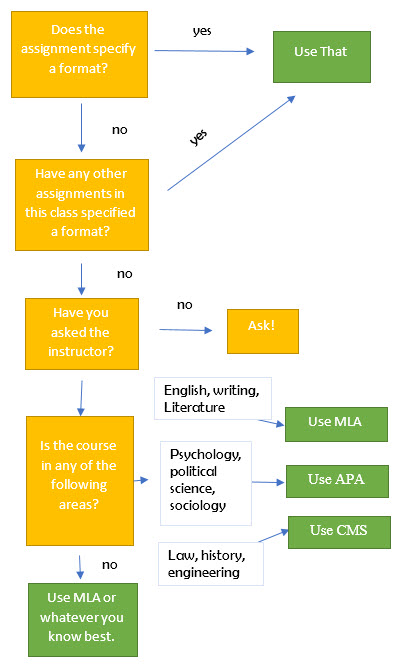Learning Objectives
- Understand common formats required of college writing
- Locate sources for assistance with formatting requirements
Why does format matter?
The way a text is presented is important. Different situations call for different styles of presentation: an e-mail looks different than a Facebook update, which looks different than a Tweet, which looks much different than a recommendation letter. When you’re writing for another audience, it’s important to work toward their expectations of how your writing should look.
In academic and professional writing, many different standards have been created to make reading multiple works easier. Three major styles of writing are used in most colleges: Modern Language Association (MLA) style, American Psychological Association (APA) style, and Chicago Manual of Style (CMS) (which is sometimes called Turabian style). Each style varies slightly in what it recommends for formatting your paper.
These formats were developed so that an instructor (or boss, or scholarship committee member) would be able to evaluate work that all appeared the same, giving more time for the reader to focus on content. In addition, particularly when dealing with citations, the style is particular so that information is easy to locate. In a Works Cited page, for instance, a reader can always quickly identify the volume number of a source because it will always appear in the same place in a magazine citation.
The most updated version of each style is maintained by the organizations themselves, which publish new style manual editions when major changes are made. As of 2018, MLA is in its 8th edition; APA is in the 6th edition; and CMS is in its 17th edition. All three sell their comprehensive guides in bookstores and online; however, most writing classes will instead assign a writing handbook, which may include brief explanations one, two, or all three styles.
None of this matters, though, if your audience (i.e., your instructor) has a specific format they require. Follow this tree to decide what style to use:

The assignment instructions should always be consulted first, followed by directly asking your instructor. If the instructor does not care (or if you’ve thought about this too late to ask), make a best guess. English, writing, literature, and other composition- or language-focused classes are likely to use MLA. Classes in the social sciences usually use APA. Chicago Style itself is meant more for book publication, but it has been applied to student writing through a handbook written by Kate Turabian. Turabian/Chicago Style is more frequently used in law, long history works, published printed books, and some engineering courses (though science courses do not have any one specific citation style; it varies by institution and instructor). Other styles also exist, including Associated Press style (for journalists), the American Medical Association style (pre-med, some nursing), and even more.
The big three, though, will cover most situations in college. The most updated versions of their styles can always be found through the associations’ official web sites:
The Big Three: Official Web sites
- Modern Language Association style guide
- American Psychological Association style guide
- Chicago Manual of Style
- Turabian quick-start guide (more useful for student writing)
All three sites provide some basic information about format and citation. However, all three sites would also like to encourage you to buy their books, so the entire style guide cannot be found there for free. Instead, many other sites have popped up to demonstrate formatting, style, and citation. Look to your library’s web site to find where they most recommend viewing additional style guide information.
However, all three provide some guidance online about formatting your paper. Here are the major recommendations, with links to further information and examples:
MLA, 8th Edition
Example papers (two papers are provided at the MLA web site)
The MLA Style Web site offers specific tips and an example of a formatted paper.
Most MLA formatted student papers do not require a title page, though some longer works (such as a thesis) may require one. In general, MLA papers should have 1″ margins on all sides. They begin with the author’s name at the top, left-hand corner of the first page (not in the header, just on the first regular line). This should be followed by the instructor’s name (with title: Professor X), then a new line with the course name and number (English 101), then a new line with the date that the assignment is being turned in (12 December 2018). The next line is the title, which is centered (but not in bold, nor underline, nor italics, nor quotations, nor larger font). At the top of every page (even the first), the author’s last name and the page number should appear at the top, right-hand side in the header.
Text should be double spaced (including the first page with the heading).
APA, 6th Edition
Example paper (in PDF, from APA web site)
The APA Web site provides a “Quick Answers” page that discusses formatting. In short: one-inch (or more) margins on each page. Text should be double-spaced. A shortened version of the paper’s title, called the Running Head, should appear at the top-left corner of each page, and a page number should be at the right-hand top corner of each page, in the header. A cover page including the running head, the paper’s title, author, and date, should come before the text, and the title of the paper should appear again, centered, on the first page of the paper.
Chicago, 17th Edition/Turabian, 8th Edition
No official examples of student work are made available by either CMS or Turabian. However, general guidelines for the 8th edition directly reflect the APA 6th edition style: Turabian papers should include 1″ or greater margins, a shortened title at the top of each page (left header) and page number (right header), and a separate title page with the title, author, author’s affiliation, and date centered.
